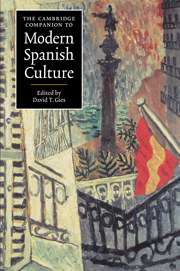16 - Theater and culture, 1936-1996
from V - Culture and theater
Published online by Cambridge University Press: 28 May 2006
Summary
Theater is more than a literary genre. The written dramatic text might be viewed in parallel with narrative or poetry, but theater encompasses performance and the practical considerations of bringing that performance to an audience. Theater is also potentially more subversive than literary works intended to be read in private; thus it has frequently been subject to greater suspicion, censorship, and repression. On the other hand, theater may be more directly open to international currents; acting companies may tour abroad, and works staged at home may come from other nations and periods. The study that follows is not limited to playwrights but rather examines various facets of stage history in postwar Spain.
The Spanish Civil War is considered a point of rupture in national culture. In the case of theater, Spain lost hundreds of playwrights, directors, and actors through death or exile: Garcia Lorca was assassinated in the early weeks of the war; Alejandro Casona wrote most of his major plays in Argentina; Cipriano de Rivas Cherif headed an acting company in Mexico; Margarita Xirgu directed theaters and acting schools in Argentina, Chile, and Uruguay. As the victorious Francoists established their national theater, suspect dramatic texts, too, were banished: the works of García Lorca, Ramón María del Valle-Inclán, and others disappeared for decades. Still, the rupture was by no means total. As César Oliva explains, prior to 12 April 1939, there was leftist theater, rightist theater, and a wide area in between without overt political bias; with the war's end, only rightist theater was allowed, but there was no decline in theatrical activity.
- Type
- Chapter
- Information
- The Cambridge Companion to Modern Spanish Culture , pp. 222 - 236Publisher: Cambridge University PressPrint publication year: 1999



